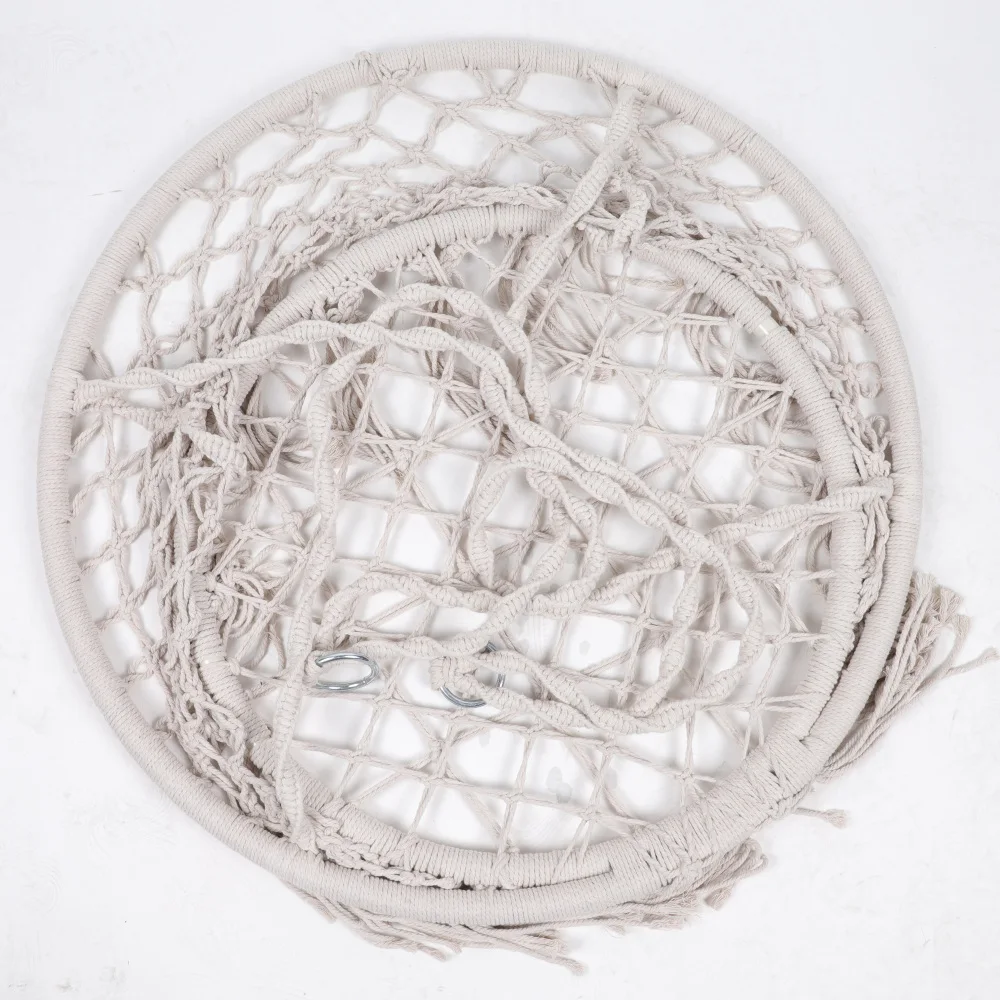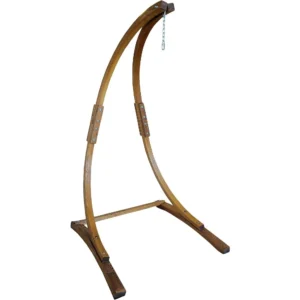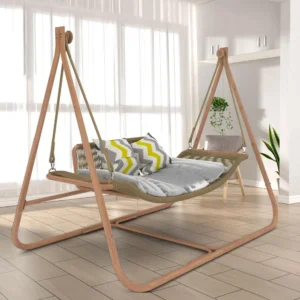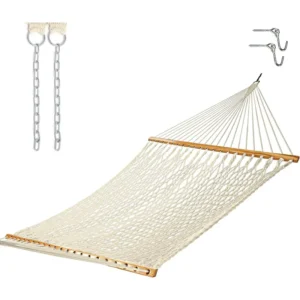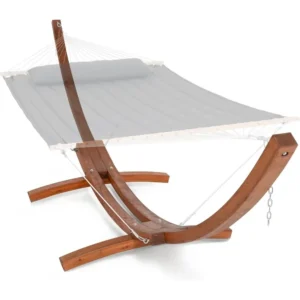Introduction: Why Material Choice Matters for Your Patio Hammock Chair
Imagine sinking into your patio hammock chair after a long day, the gentle swinging motion lulling you into a state of perfect relaxation. The fabric cradles you just right, the frame holds steady, and the whole experience feels like a mini-vacation in your own backyard. This blissful scenario only happens when you’ve chosen the right materials for your outdoor retreat.
The materials used in your hammock chair determine virtually everything about your experience – from how long it lasts in harsh weather to how comfortable it feels against your skin. Poor material choices can lead to disappointment: fabric that fades after just one season, ropes that fray and weaken, or frames that develop rust spots and become unstable.
While swinging hammock chairs offer incredible relaxation benefits, choosing the wrong materials can transform your dream retreat into an ongoing source of frustration. The difference between a cotton hammock chair that feels heavenly but quickly mildews in damp conditions and a synthetic option that withstands rain but lacks comfort illustrates why material selection deserves careful consideration.
This guide will help you navigate the world of hammock chair materials, focusing specifically on options suitable for patio-friendly swinging hammock chairs. We’ll examine everything from fabrics to frames, ropes to hardware, giving you the knowledge to select materials that perfectly match your comfort needs, climate challenges, and aesthetic preferences.
Essential Properties of Outdoor Hammock Chair Materials
Before diving into specific material types, let’s establish what makes certain materials excel in outdoor environments. These fundamental properties will serve as our evaluation framework throughout this guide.
Weather Resistance Properties
- UV Protection: Materials with high UV resistance maintain color and structural integrity despite prolonged sun exposure
- Water Repellency: How quickly materials dry and resist water absorption
- Mildew/Mold Resistance: Ability to resist fungal growth in humid conditions
- Temperature Stability: Materials that don’t become brittle in cold or overly soft in heat
The importance of these factors cannot be overstated – comprehensive weather protection for patio hammock chairs can extend their lifespan by years. For instance, UV-stabilized fabrics often maintain their color and strength for 3-5 years or more, while untreated fabrics might fade or degrade within months.
Durability Factors
- Abrasion Resistance: Withstanding regular friction without showing wear
- Tensile Strength: Ability to support weight without stretching or tearing
- Structural Integrity: How well materials maintain their shape over time
- Rot/Decay Resistance: Important particularly for natural materials
Comfort Elements
- Breathability: How well air circulates through the material
- Texture: Smoothness or roughness against skin
- Flexibility: How the material conforms to body contours
- Weight Distribution: How effectively pressure points are eliminated
Maintenance Requirements
- Cleaning Ease: How simply dirt and stains can be removed
- Stain Resistance: Natural ability to resist permanent marking
- Repair Feasibility: Whether damage can be fixed or requires replacement
Aesthetic Considerations
- Color Options: Available palette and color retention
- Visual Texture: How materials contribute to overall design
- Aging Characteristics: Whether materials develop patina or simply degrade
Fabric Materials: Finding the Perfect Balance of Comfort and Durability
The fabric of your hammock chair is what you’ll feel against your skin, making it perhaps the most important material choice for comfort. However, it must also withstand outdoor conditions.
Solution-Dyed Acrylics (Sunbrella, etc.)
Pros:
* Premium UV resistance (retains approximately 98% color after 500 hours of UV exposure)
* Exceptional water repellency with quick-drying properties
* Highly resistant to mold, mildew, and staining
* Soft, cotton-like feel despite synthetic composition
* Available in numerous colors and patterns
Cons:
* Higher price point than most other options
* Slightly less breathable than mesh options
* May require special cleaning products for tough stains
Solution-dyed acrylics represent the gold standard for outdoor fabrics, with color that goes to the core of each fiber rather than being applied to the surface. This creates unmatched fade resistance that justifies the premium price for many outdoor enthusiasts.
Polyester
Pros:
* Good UV resistance at a moderate price point
* Dries reasonably quickly after rain
* Maintains strength when wet
* Wide variety of weights, textures, and colors
* Easy to clean with standard household products
Cons:
* Less fade-resistant than solution-dyed acrylics
* May pill or show wear over time
* Lower-grade polyesters can feel rough against skin
Polyester offers excellent value as a mid-range option, providing acceptable performance across most categories without the premium price of solution-dyed acrylics. It’s particularly suitable for hammock chairs that receive partial shade during the day.
Olefin/Polypropylene
Pros:
* Naturally water-resistant and quick-drying
* Lightweight with good strength-to-weight ratio
* Resistant to mold, mildew, and chemicals
* Colorfast and UV-resistant properties
* Generally affordable price point
Cons:
* Can degrade faster under extremely high temperatures
* Sometimes less soft than other synthetic options
* Limited textures compared to polyester or acrylics
Olefin offers excellent moisture handling, making it ideal for humid climates or poolside locations where quilted lounging hammocks might regularly get wet.
Textilene/PVC Mesh
Pros:
* Maximum airflow for hot climates
* Extremely quick-drying (often dry within minutes)
* Very low maintenance, easily hosed off when dirty
* Resistant to UV damage, mildew, and chlorine
* Maintains tension without stretching over time
Cons:
* Firmer feel, less cushioning than fabric options
* Limited color palette compared to fabrics
* Utilitarian appearance may not suit all aesthetic preferences
Mesh fabrics excel in hot, humid environments where breathability is the top priority. The open weave allows air circulation that prevents the sticky, sweaty feeling other materials might create in high heat.
Cotton and Natural Fibers
Pros:
* Exceptional softness and comfort against skin
* Breathable with excellent temperature regulation
* Natural aesthetic that many find appealing
* Often available in organic varieties
* May develop character and softness with age
Cons:
* High maintenance in outdoor settings
* Prone to mildew and rot if frequently wet
* Less durability than synthetic alternatives
* Requires regular cleaning and proper storage
While cotton offers unmatched comfort, it demands significant maintenance for outdoor use. For those willing to bring their hammock chair indoors during inclement weather, however, natural fibers provide a comfort experience that synthetics struggle to match.
For a wide selection of material options, browse our fabric hammock sets collection featuring various fabric types to suit different preferences.
Frame Materials: The Backbone of Your Hammock Chair
The frame of your hammock chair provides structural support and significantly impacts both safety and visual appeal. Different materials offer varying degrees of strength, weather resistance, and aesthetic appeal.
Metal Options
Aluminum
Pros:
* Naturally rust-resistant without additional treatments
* Lightweight yet strong enough for most users
* Minimal maintenance requirements
* Modern, sleek appearance
* Good strength-to-weight ratio
Cons:
* Can dent more easily than steel
* Premium aluminum frames can be costly
* Limited finish options compared to wood
* May feel cold to touch in cooler weather
Powder-Coated Steel
Pros:
* Exceptional strength and weight capacity (typically 250-400 lbs)
* Excellent stability even with vigorous movement
* Affordable price point for the durability offered
* Available in numerous color options
* Substantial, sturdy feel
Cons:
* Can rust if the coating gets scratched or damaged
* Heavier than aluminum or wood options
* Requires occasional inspection for coating damage
* May become hot in direct sunlight
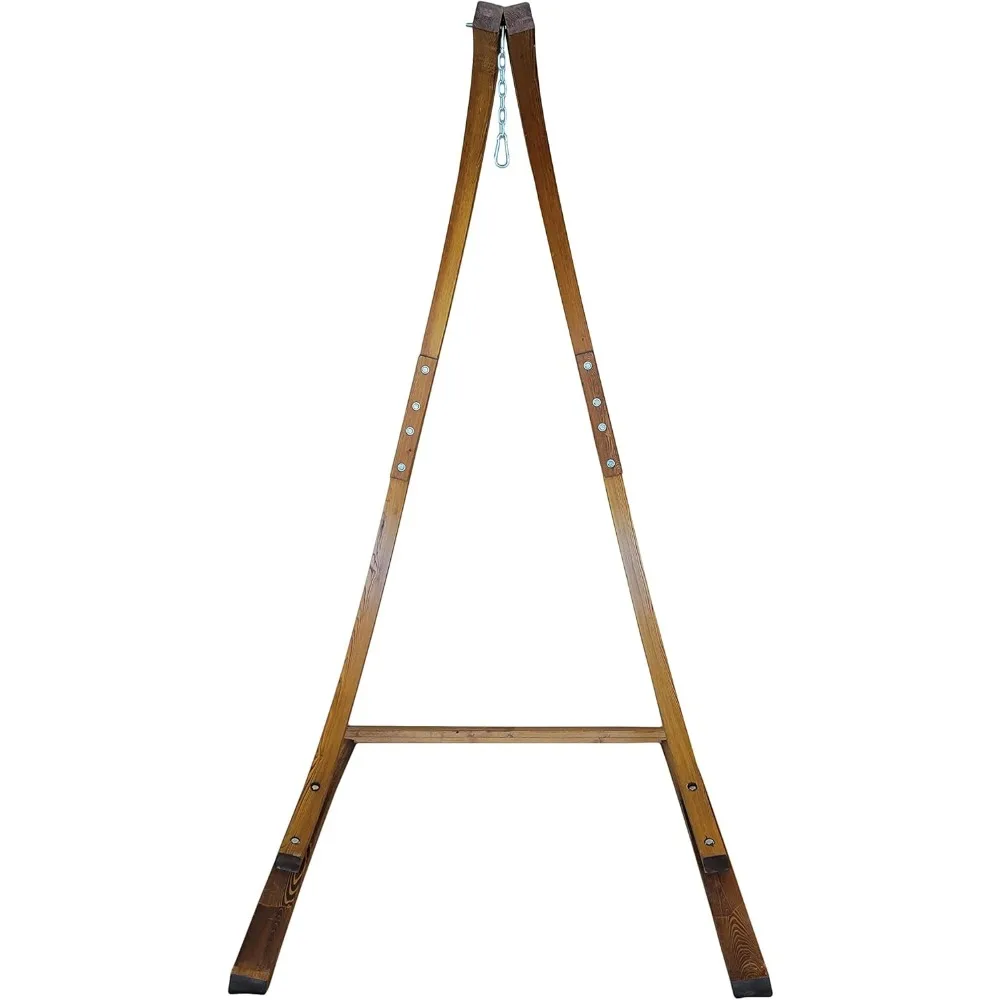
Wood Variations
Teak
Pros:
* Natural oils provide exceptional weather resistance
* Develops attractive silver-gray patina over time
* Very durable with 15-20+ year potential lifespan
* Classic, premium appearance
* Resists insect damage naturally
Cons:
* High initial investment cost
* Heavier than metal options
* Requires occasional oil treatment to maintain original color
* Not as portable as metal frames
Eucalyptus
Pros:
* Similar properties to teak at a lower price point
* Natural oils provide good weather resistance
* Attractive grain and rich color
* Sustainable growth and harvest practices
* Good strength and durability (5-10 year lifespan)
Cons:
* Requires more maintenance than teak
* May develop cracks without proper seasonal care
* Not quite as long-lasting as premium teak
Cedar
Pros:
* Natural aromatics repel insects
* Beautiful reddish color and distinctive grain
* Lightweight compared to other hardwoods
* Natural resistance to rot and decay
* Moderate price point
Cons:
* Will weather to gray unless regularly treated
* Less dense and potentially less durable than teak or eucalyptus
* Requires seasonal protective treatments for maximum longevity
For frame strength information, our guide on strongest materials for hammock stands provides detailed analysis of weight capacities and structural integrity factors.
Synthetic Wicker/Resin
Pros:
* Convincing natural appearance without natural material drawbacks
* Completely waterproof and UV-resistant
* Minimal maintenance requirements
* Lightweight with good durability
* Resistant to cracking, peeling, and fading
Cons:
* Quality varies significantly between manufacturers
* Lower-grade options can appear obviously artificial
* Less structural strength than metal or hardwood frames
* May become brittle over time with continuous UV exposure
Our wooden hammocks stands collection showcases various options that combine durability with natural beauty for patio settings.
Rope and Suspension Materials: Critical Components for Safety and Style
The ropes and suspension elements of your hammock chair play a crucial dual role: they provide essential structural support while also contributing significantly to the overall aesthetic.
Synthetic Rope Options
Polyester
Pros:
* Excellent UV and weather resistance
* Minimal stretching when supporting weight
* Good abrasion resistance for high-wear points
* Available in various colors and thicknesses
* Relatively soft feel compared to other synthetics
Cons:
* Less natural appearance than cotton or hemp
* Can be slippery when new
* Premium marine-grade versions cost more but last significantly longer
Nylon
Pros:
* Superior strength-to-weight ratio
* Significant stretch capacity provides gentle give
* Soft feel against skin
* Good resistance to abrasion
* Dries quickly after exposure to moisture
Cons:
* Less UV-resistant than polyester or polypropylene
* Can degrade faster in consistently sunny locations
* Stretch properties require occasional tension adjustment
Polypropylene
Pros:
* Floats in water (ideal for poolside installations)
* Highly resistant to mold and mildew
* Does not absorb water
* Typically the most affordable synthetic option
* Available in bright, vibrant colors
Cons:
* Less soft than polyester or nylon
* Can be more slippery than natural fibers
* Lower breaking strength than polyester in similar diameters
Natural Fiber Ropes
Cotton
Pros:
* Exceptionally soft and comfortable against skin
* Natural appearance with beautiful texture
* Excellent grip (doesn’t slip when sitting)
* Breathable even in hot weather
* Authentic traditional hammock chair appearance
Cons:
* Requires regular maintenance and cleaning
* Must be brought indoors during inclement weather
* Prone to mildew and rot if consistently damp
* Gradually weakens with UV exposure
Hemp and Jute
Pros:
* Stronger than cotton with better weather resistance
* Eco-friendly, sustainable material choice
* Distinctive natural texture and appearance
* Moderate durability in protected outdoor settings
* Develops character and softens with age
Cons:
* Rougher texture than cotton, especially when new
* Still susceptible to rot and mildew though less than cotton
* Requires seasonal maintenance and protection
* Limited color options without dyeing
For visual examples of various rope styles and applications, visit our rope hammock sets collection page.
Hardware Materials
- Stainless Steel: Maximum corrosion resistance, ideal for coastal environments
- Galvanized Steel: Good rust resistance at a moderate price point
- Brass: Attractive appearance that develops patina, moderate corrosion resistance
- Chrome-Plated: Attractive shine but requires protection from scratches to prevent rust
Material Performance Comparison Chart: At-A-Glance Decision Guide
| Material Type | Weather Resistance | Durability | Comfort | Maintenance | Cost Range | Best Use Scenario |
|---|---|---|---|---|---|---|
| Solution-Dyed Acrylic | Excellent | Excellent | Very Good | Low | $$$ | Long-term patio installation with full sun exposure |
| Polyester | Very Good | Good | Good | Low | $$ | Balance of performance and value for moderate climates |
| Olefin | Excellent | Good | Good | Very Low | $$ | Humid or wet environments |
| Textilene Mesh | Excellent | Excellent | Fair | Very Low | $$ | Hot climates prioritizing airflow |
| Cotton | Poor | Fair | Excellent | High | $-$$ | Protected locations with regular maintenance |
| Aluminum Frame | Excellent | Very Good | N/A | Very Low | $$$ | Lightweight, modern aesthetic needs |
| Powder-Coated Steel | Very Good | Excellent | N/A | Low | $$ | Maximum strength requirements |
| Teak | Very Good | Excellent | N/A | Low-Moderate | $$$$ | Premium, long-term installation |
| Synthetic Wicker | Very Good | Good | N/A | Very Low | $$ | Natural look without maintenance |
| Polyester Rope | Excellent | Very Good | Good | Low | $$ | All-purpose outdoor use |
| Cotton Rope | Poor | Fair | Excellent | High | $ | Comfort priority with proper care |
Our collection of swinging hammock chair sets offers various material combinations to match your specific requirements.
Best Material Choices for Specific Weather Conditions
The local climate should heavily influence your material selections. Here’s how to match materials to your specific environmental challenges:
Hot and Sunny Environments
- Solution-dyed acrylics or olefin fabrics provide maximum UV resistance
- Textilene mesh offers superior airflow to prevent heat buildup
- Aluminum frames won’t become excessively hot to touch
- Synthetic ropes with UV inhibitors maintain strength despite sun exposure
- Consider lighter colors that reflect rather than absorb heat
Humid and Rainy Regions
- Olefin or polyester fabrics dry quickly after rain
- Synthetic mesh allows water to pass through without pooling
- Aluminum, teak, or powder-coated steel with proper drainage holes
- Avoid cotton or natural fibers that promote mold growth
- Waterproof materials for hammocks are essential in these regions
- Choose synthetic ropes specifically designed for marine environments
Coastal Areas
- Stainless steel hardware resists salt corrosion
- Solution-dyed acrylics resist salt spray damage
- Aluminum frames won’t rust with salt exposure
- Synthetic ropes designed for marine use maintain integrity
- Regular freshwater rinses extend material life regardless of type
Seasonally Variable Climates
- Quick-remove fabric systems allow seasonal storage
- Powder-coated steel offers good all-season durability
- Solution-dyed acrylics provide multi-season protection
- Materials with temperature stability avoid becoming brittle in cold
- Storage options during extreme weather periods
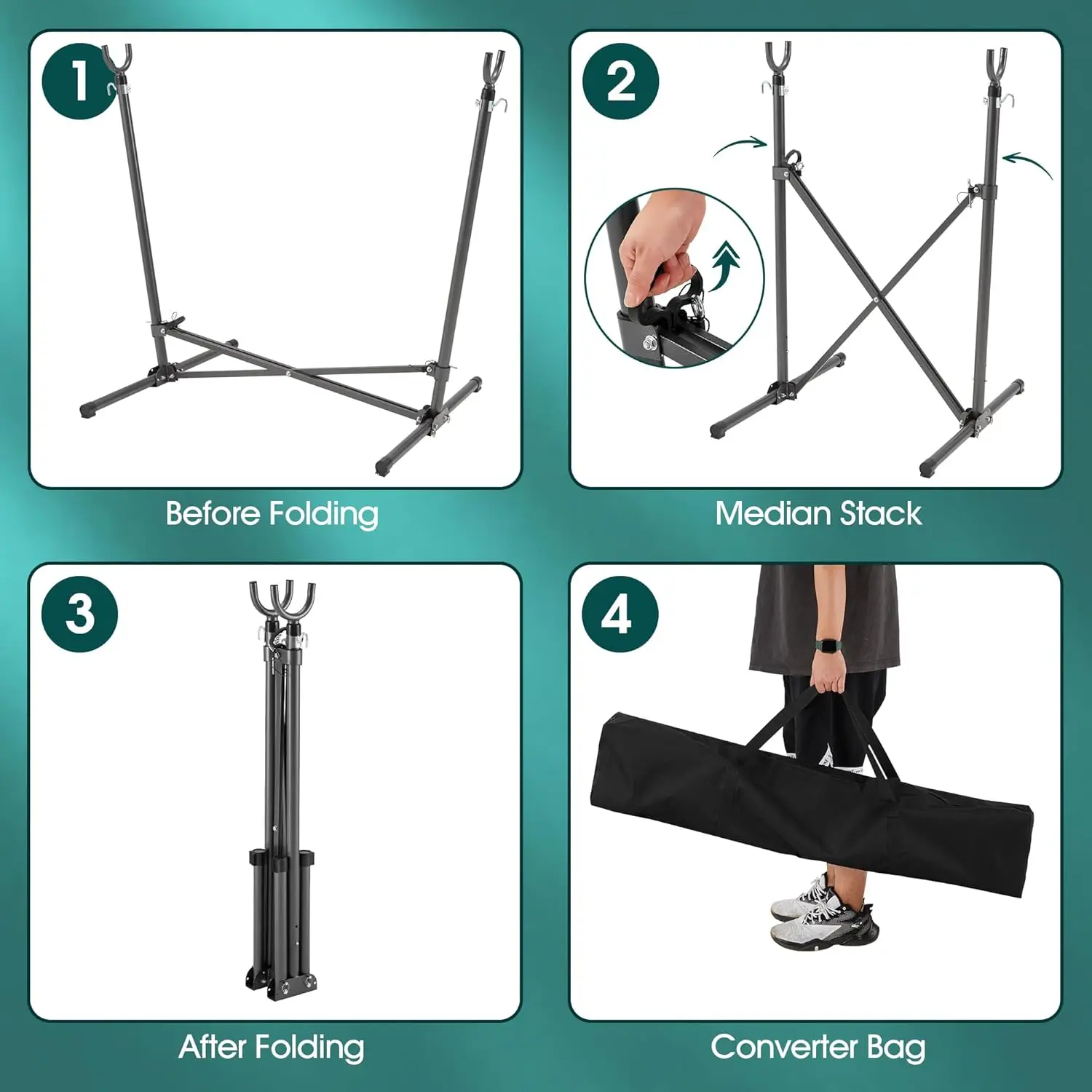
How Different Materials Affect Your Hammock Chair Experience
Beyond technical specifications, the materials you choose create distinctly different sensory experiences when using your hammock chair.
The tactile quality of fabric directly impacts comfort – natural cotton feels soft and breathable against bare skin but may cause more pressure points than a properly designed synthetic weave that distributes weight more evenly. Rope spacing and texture significantly affect how the chair conforms to your body, with tightly woven cotton creating a more cocoon-like feel than widely spaced synthetic rope designs.
Weight differences between materials also influence the overall experience. Heavier cotton chairs provide a sense of security and substantial comfort, while lightweight synthetic options create an almost floating sensation. These materials for hammock chairs directly impact how you experience relaxation.
Sound represents another often-overlooked aspect of the hammock chair experience. Natural fibers tend to create subtle, organic creaking sounds as they flex and adjust to movement, while synthetic materials typically operate more silently. For some users, these gentle natural sounds enhance relaxation, while others prefer the silent operation of synthetics.
Temperature management varies dramatically between materials. Mesh and open-weave designs allow airflow that keeps you cool in summer heat, while denser cotton fabrics provide more insulation during cooler evenings. This consideration becomes particularly important if you plan year-round use in variable climates.
Matching Materials to Your Outdoor Aesthetic
Your hammock chair should complement your overall patio design rather than clash with it. Here’s how different materials align with popular outdoor aesthetics:
Modern Minimalist
- Aluminum frames with clean lines and minimal ornamentation
- Textilene or solution-dyed acrylic in solid, neutral colors
- Thin synthetic rope in geometric patterns
- Emphasis on function with restrained visual impact
- Materials that maintain a crisp, clean appearance
Bohemian/Eclectic
- Macramé cotton rope in intricate patterns
- Natural fibers with handcrafted appearance
- Mixed materials with visible texture
- Earth tones or vibrant jewel colors
- Materials that develop character with age and use
Traditional/Classic
- Hardwood frames in rich, natural finishes
- Cotton rope in time-tested patterns
- Solid colors or subtle stripes in fabric options
- Materials that reference historical hammock designs
- Emphasis on craftsmanship and traditional techniques
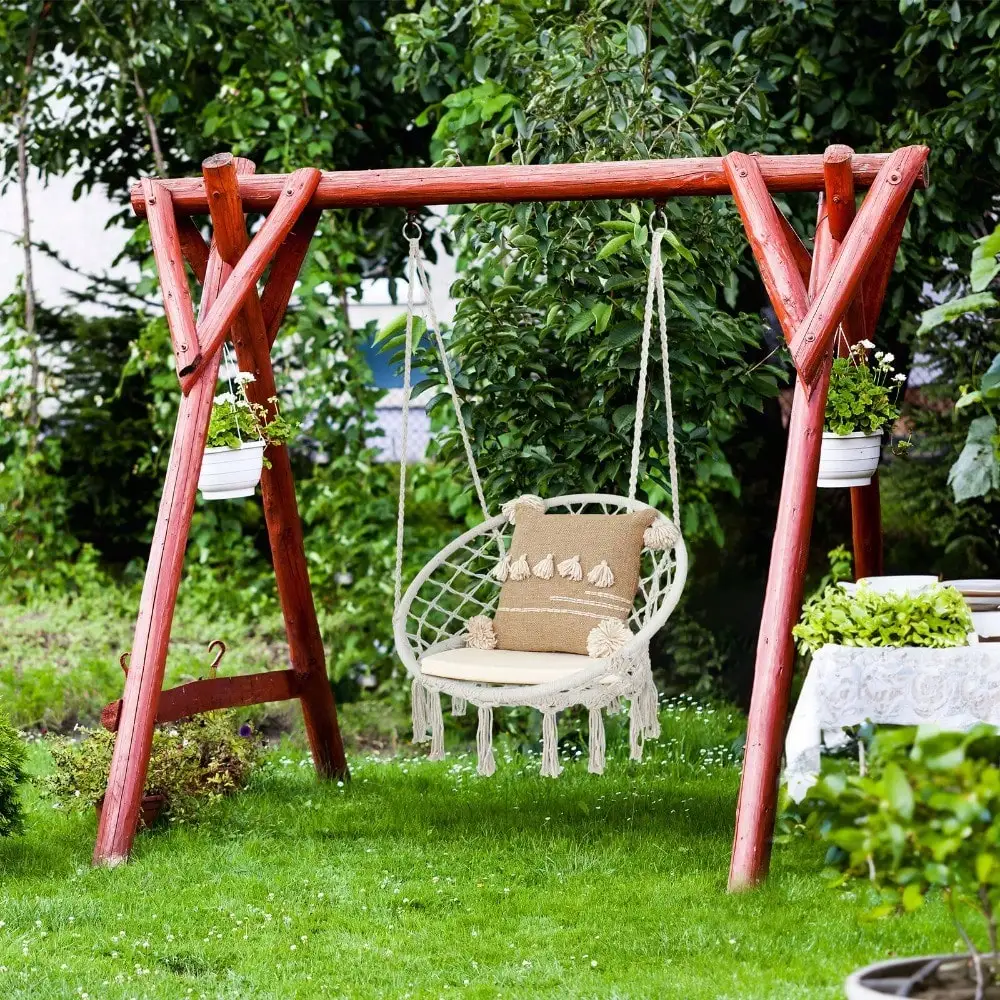
Tropical/Resort Style
- Teak or eucalyptus frames with visible grain
- Bright, saturated colors in weather-resistant fabrics
- Thicker rope elements with casual drape
- Materials that evoke vacation destinations
- Combination of natural appearance with weather resistance
Rustic/Farmhouse
- Cedar or reclaimed wood frames with visible texture
- Natural fiber ropes with substantial thickness
- Neutral colors with occasional subtle patterns
- Materials that appear artisanal rather than mass-produced
- Elements that develop patina and character over time
Our hammock chairs stands collection offers various material combinations to match your specific aesthetic preferences.
Maintaining Your Patio Hammock Chair: Material-Specific Care Tips
Proper maintenance dramatically extends the life of your hammock chair materials. Follow these material-specific care guidelines:
Fabric Care
- Solution-dyed Acrylics: Clean with mild soap and water; brush off loose dirt when dry; treat stains promptly with diluted bleach solution if necessary
- Polyester: Machine wash removable components in cold water with mild detergent; air dry completely
- Olefin: Rinse with hose; use soft brush with mild soap for stubborn dirt; can handle stronger cleaning solutions when needed
- Textilene/Mesh: Hose off regularly; scrub with soft brush and mild detergent for stubborn grime
- Cotton: Hand wash in cold water; air dry completely before storage; treat mildew immediately if it appears
Frame Maintenance
- Aluminum: Wipe with damp cloth; use mild soap for stubborn dirt; check connections annually
- Powder-Coated Steel: Inspect for scratches in coating; touch up promptly with matching paint; tighten hardware seasonally
- Wood (all types): Apply appropriate oil or sealant annually; check for cracks or splitting; tighten all hardware regularly
- Synthetic Wicker: Rinse with water; use soft brush for dirt in weave pattern; avoid pressure washers
Rope and Suspension Maintenance
- All Rope Types: Check regularly for fraying or weakening, particularly at connection points
- Natural Fibers: Inspect after rain; never store damp; retreat with appropriate protectants seasonally
- Synthetic Ropes: Rinse occasionally to remove pollen and environmental grime; check UV damage annually
- Hardware: Tighten regularly; lubricate moving parts; replace any components showing significant rust or wear
Seasonal Care Routines
- Spring: Deep clean all components; check for winter damage; apply protective treatments
- Summer: Rinse regularly to prevent pollen and dirt buildup; provide shade if possible
- Fall: Clean thoroughly before reduced use; apply protective treatments
- Winter: Store properly or use weather-protective covers; remove fabric components when possible
Dark Wood Hammock Sets, Porch Swing Chair Sets
$653.82 Select options This product has multiple variants. The options may be chosen on the product pageA-Frame Stand Hammock Sets, Swinging Hammock Chair Sets
$154.62 Select options This product has multiple variants. The options may be chosen on the product pageLight Wood Hammock Sets, Swinging Hammock Chair Sets
$1,359.35 Select options This product has multiple variants. The options may be chosen on the product pageClassic Wooden Stand Hammock Sets, Heavy Duty Hammock Sets
$1,061.68 Select options This product has multiple variants. The options may be chosen on the product pageDouble / Two Person Hammock Sets, Rope Hammock Sets
Double Traditional Cotton Rope Hammock with Extension Chains – 450 lbs Capacity for Backyard & Patio$292.98 Select options This product has multiple variants. The options may be chosen on the product pageHeavy Duty Hammock Sets, Wooden Arc Stand Hammock Sets
$878.66 Select options This product has multiple variants. The options may be chosen on the product page
For detailed information on maintaining specific features, our guide on swing chair features provides additional insights on care requirements.
The exceptional comfort provided by deep seat chair hammock sets makes proper maintenance especially important to preserve their plush feel and support.
Investment Value: Balancing Cost with Longevity
When evaluating hammock chair materials, consider the total cost of ownership rather than just the initial purchase price. Premium materials often deliver superior value over time despite higher upfront costs.
For example, a hammock chair with solution-dyed acrylic fabric and a powder-coated steel frame might cost twice as much as a basic polyester/steel option. However, the premium chair could last 5-7 years with minimal maintenance, while the budget option might need replacement after 2-3 seasons – ultimately making the higher-quality option more economical per year of use.
Expected lifespan under typical conditions:
* Solution-dyed acrylic fabric: 5-7+ years
* Quality polyester fabric: 3-5 years
* Basic polyester fabric: 1-3 years
* Teak frame: 15-20+ years
* Powder-coated steel frame: 5-10 years
* Basic steel frame: 2-5 years
When budgeting, consider investing in premium materials for components that receive the most stress and weather exposure, particularly the fabric and suspension system. The guide to choosing outdoor fabric hammocks provides additional context on making value-based material selections.
Also consider the availability of replacement parts – modular designs that allow component replacement often provide better long-term value than all-in-one constructions that require complete replacement if one element fails.
FAQs: Expert Answers to Common Material Questions
Can natural materials really work for outdoor hammock chairs?
Natural materials can work outdoors with proper care and maintenance. Cotton, hemp, and wood require protection from prolonged moisture and regular treatments with appropriate preservatives. They perform best in covered areas with limited direct weather exposure. For long-term outdoor placement, synthetic alternatives typically provide better durability with less maintenance.
What’s the difference between solution-dyed and regular acrylic fabrics?
Solution-dyed acrylics have color added during fiber creation rather than after the fabric is woven. This means the color permeates the entire fiber rather than just coating the surface. The result is significantly better fade resistance, as the color can’t simply wear off from sun exposure or abrasion. Solution-dyed fabrics typically maintain their appearance 3-4 times longer than surface-dyed alternatives.
How much weight can different frame materials safely support?
Weight capacities vary by design as much as material, but general ranges include:
* Powder-coated steel: 250-450 pounds
* Aluminum: 200-350 pounds
* Hardwoods (teak, etc.): 250-400 pounds
* Synthetic wicker frames: 200-300 pounds
Always check manufacturer specifications, as engineering details significantly impact capacity regardless of material.
Are there eco-friendly material options for outdoor hammock chairs?
Yes, several eco-friendly options exist. FSC-certified hardwoods ensure sustainable harvesting practices. Organic cotton provides a natural option without synthetic pesticides. Recycled polyester fabrics repurpose plastic waste into durable outdoor textiles. Hemp offers exceptional strength with minimal environmental impact. While these options sometimes require more maintenance, they provide environmentally conscious alternatives to conventional materials.
How do I know when it’s time to replace my hammock chair due to material degradation?
Watch for these warning signs by material type:
* Fabric: Visible thinning, ease of creating tears, significant fading
* Rope: Fraying that exposes inner fibers, notable stretching under weight
* Wood: Cracking that goes beyond surface, softness when pressed firmly
* Metal: Rust that penetrates beyond surface, wobbling at connection points
The key concern is safety – if you feel any uncertainty about structural integrity when perfectly positioning your swing hammock chair, it’s time to replace components or the entire chair.
Making Your Final Decision: Prioritizing What Matters Most
When selecting materials for your patio hammock chair, focus on the factors that most directly impact your specific situation and preferences.
For areas with intense weather conditions, prioritize durability and weather resistance above all else – solution-dyed acrylics, powder-coated steel, and synthetic ropes provide the best defense against environmental challenges. In protected locations with milder conditions, you gain the freedom to prioritize comfort and aesthetics through natural materials or design-focused options.
Consider your maintenance willingness honestly. The most beautiful natural materials require regular care, while synthetic alternatives offer nearly maintenance-free enjoyment. This time investment should factor significantly into your decision process.
Remember that the perfect hammock chair creates a personal retreat that enhances your outdoor living space. By selecting materials that align with your climate needs, comfort preferences, and aesthetic vision, you create not just a piece of furniture but a destination for relaxation that will provide years of enjoyment.
At Outside Luxe, we believe that understanding material properties empowers you to make choices that enhance your outdoor living experience through quality, comfort, and durability – the essential elements of true outdoor luxury.

